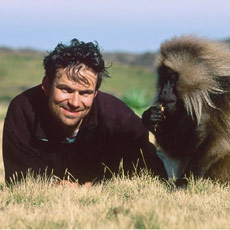
Polar Bears, Humpbacked Whales, and Elephants - Experience the Planet Like Never Before

Ever wonder about the world’s largest land predator, how soon newborn whale calves are able to swim, or the little-known function of an elephant’s ears? While the answers might surprise and amuse you, it’s the adventure these questions pose that promises to be unforgettable. On April 22, you’re invited to experience an epic journey when Disneynature premieres “Earth,” the Company’s first wildlife film in over 60 years, continuing a legacy that began with Walt Disney’s Academy Award®-winning “True-Life Adventures.” Narrated by screen, stage, and television legend James Earl Jones, “Earth” reveals the seasonal struggles facing three animal families from the Arctic to Antarctica … and some of the planet’s most remote regions in between.
Acclaimed wildlife filmmaker/director Mark Linfield tells why he and director/partner Alistair Fothergill chose polar bears, humpbacked whales, and elephants as their endearing main stars. “One thing that unites every being on the planet is the sun and its annual north-south journey. We wanted to document three animals that embark on incredible migrations due to the influence of the sun’s extreme seasonality … and these are large, engaging animals that we felt people could relate to. As the moviemaking went on, it became clear to us that we wanted a very subtle reference toward the future and conservation, which is why they had calves or cubs. Many of us have little ones and we’re always thinking of what the world will be like for them and their children. Most of the animals’ dramas are driven by their quest to protect their infants and get the best out of the planet for their offspring … nature truly writes the most amazing scripts.”
To record “true” true-life adventures, there’s one thing Mark and his team couldn’t change, accelerate, or follow with a script — the erratic schedule of nature itself. He points out, “You’re lucky if the animals show up at all. Most days we didn’t see anything, that’s almost the law … the only way to stack the odds in your favor is to spend huge amounts of time in the field. We spent 2,000 days filming with 40 different crews in 26 different countries. It took about five years to make and we filmed solidly for three of those years … it was just a big logistical exercise, but that’s what it takes. Movies like this are powerful partly because it’s the simple truth.” Mark also explains that natural history actually translates better on the big screen because some of the up-close realism is lost when viewed on television.
Larger than life, the animals’ determined battle against the elements is amazing, entertaining, and ultimately heartrending. Extreme weather conditions from pole to pole presented unique, and nearly impossible, filming challenges. “Just look at the environments that our three characters live in … like the polar bear. We’re actually in the middle of the with crews working in 40-degree-below-zero temperatures. It’s so unbelievably cold that most of the time the equipment barely works or the tripod sticks to your fingers. Daylight was like five or six minutes long, which means it was dark the rest of the time. Polar bears are hugely influenced by the seasonality of the sun — half their year is spent in absolute darkness while the other half produces 24-hour daylight,” says Mark. The team was the first ever to be given access to the Kong Karls Land polar bear denning site in Norway, 700 miles south of the North Pole.
Conditions proved no easier when the crew was filming the elephants in Botswana, the Sahara and Kalahari Deserts, and Namibia’s sand dunes, some of the largest in the world. “We worked in unbelievable heat, dust, and sandstorms … without water. The elephants aren’t affected from changes in daylight, but the sun drives the wet and dry seasons, forcing them to undertake huge migrations — their quest to finally find water hundreds of miles away at the Okavango Delta is pretty dramatic.” From helicopters, gyro-stabilized Cineflex aerial cameras allowed filmmakers to track the animals without disturbing them in their natural environment.
“For the humpbacked whales, we filmed from a boat at sea, sometimes in a helicopter, through storms and a huge range of conditions,” he continues. “The mother whale and her calf travel 4,000 miles south, from the Equator’s tropical waters to the Antarctic Sea … it’s the longest journey of any marine mammal.” During the course of filming, the crew was able to feature dozens of marine costars, including schools of sailfish and a great white shark … the footage is nothing short of spectacular.
The journey, as always, proved fantastic for Mark, who doesn’t hesitate when asked about his most memorable moment. “Filming the elephants caught in the sandstorm … it was totally unexpected. Just watching them trapped in a sandstorm, trying to battle the elements while looking after their calves, was very sad and emotional for me.”
He then comments on his expectations for the film. “I hope people will fall in love with the Earth and basically see how much there still is to care about. Everything in the movie is available and can be saved. I hope people realize it’s not futile, it’s not too late … we have an absolutely amazing planet.”
“Earth” promises to give audiences 85 amazing minutes that wouldn’t be humanly possible in an entire lifetime … or 10 lifetimes.
Source: Disney Insider
Related Articles:
- 25% of Wild Mammal Species Are Imperiled
- Texts From Elephant Warn Rangers of Trouble
- Alternative Oscars: The Most Humane Animal Movies
- Special Screening of Beverly Hills Chihuahua Movie For Chihuahua and Their Owners
- More Photos From Beverly Hills Chihuahua Movie Premier
- Philosophical and Legal Aims of the Animal Liberation Movement
|
No comments:
Post a Comment